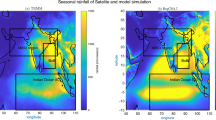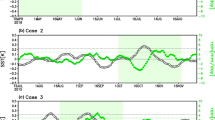Abstract
Boreal summer sub-seasonal variability in the Asian monsoon, otherwise known as the monsoon intra-seasonal oscillation (MISO), is one of the dominant modes of intraseasonal variability in the tropics, with large impacts on total monsoon rainfall and India’s agricultural production. However, our understanding of the mechanisms involved in MISO is incomplete and its simulation in various numerical models is often flawed. In this study, we focus on the objective evaluation of the fidelity of MISO simulation in the Met Office Global Seasonal forecast system version 5 (GloSea5), an initialized coupled model. We analyze a series of nine-member hindcasts from GloSea5 over 1996–2009 during the peak monsoon period (July–August) over the South-Asian monsoon domain focusing on aspects of the time-mean background state and air–sea interaction processes pertinent to MISO. Dominant modes during this period are evident in power spectrum analysis, but propagation and evolution characteristics of the MISO are not realistic. We find that simulated air–sea interactions in the central Indian Ocean are not supportive of MISO initiation in that region, likely a result of the low surface wind variance there. As a consequence, the expected near-quadrature phase relationship between SST and convection is not represented properly over the central equatorial Indian Ocean, and northward propagation from the equator is poorly simulated. This may reinforce the equatorial rainfall mean state bias in GloSea5.

















Similar content being viewed by others
References
Abhilash S, Sahai AK, Borah N, Chattopadhyay R, Joseph S, Sharmila S, De S, Goswami BN, Kumar Arun (2014) Prediction and monitoring of monsoon intraseasonal oscillations over Indian monsoon region in an ensemble prediction system using CFSv2. Clim Dyn. doi:10.1007/s00382-013-2045-9
Ajayamohan RS, Rao SA, Luo JJ, Yamagata T (2009) Influence of Indian Ocean Dipole on boreal summer intraseasonal oscillations in a coupled general circulation model. J Geophys Res 114:D06119. doi:10.1029/2008JD011096
Annamalai H, Slingo JM (2001) Active/break cycles: diagnosis of the intraseasonal variability over the Asian summer monsoon. Clim Dyn 18:85–102
Annamalai H, Sperber KR (2005) Regional heat sources and the active and break phases of boreal summer intraseasonal (30–50 day) variability. J Atmos Sci 62:2726–2740
Bentamy A, Katsaros KB, Alberto M, Drennan WM, Forde EB, Roquet H (2003) Satellite estimates of wind speed and latent heat flux over the global oceans. J Clim 16:637–656
Best MJ et al (2011) The joint UK land environment simulator (JULES), model description–part 1: energy and water fluxes. Geosci Model Dev 4:677–699. doi:10.5194/gmd-4-677-2011
Bowler N, Arribas A, Beare S, Mylne KE, Shutts G (2009) The local ETKF and SKEB: upgrades to the MORGREPS short-range ensemble prediction system. Q J R Meteorol Soc 135:767–776
de Boyer M, Madec CG, Fischer AS, Lazar A, Iudicone D (2004) Mixed layer depth over the global ocean: an examination of profile data and a profile-based climatology. J Geophys Res 109:C12003
Dee DP, Uppala SM, Simmons AJ, Berrisford P, Poli P, Kobayashi S, Andrae U, Balmaseda MA, Balsamo G, Bauer P, Bechtold P, Beljaars ACM, van de Berg L, Bidlot J, Bormann N, Delsol C, Dragani R, Fuentes M, Geer AJ, Haimberger L, Healy SB, Hersbach H, Hólm EV, Isaksen L, Kållberg P, Köhler M, Matricardi M, McNally AP, Monge-Sanz BM, Morcrette JJ, Park BK, Peubey C, de Rosnay P, Tavolato C, Thépaut JN, Vitart F (2011) The ERA-Interim reanalysis: configuration and performance of the data assimilation system. Q J R Meteorol Soc 137:553–597. doi:10.1002/qj.828
Duchon CE (1979) Lanczos filtering in one and two dimensions. J Appl Meteorol 18:1016–1022
Fu X, Wang B, Li T, McCreary JP (2003) Coupling between northward propagating, intraseasonal oscillations and sea-surface temperature in the Indian Ocean. J Atmos Sci 60:1733–1783
Goswami BN (2011) South Asian summer monsoon. In: Lau WKM, Waliser DE (eds) Intraseasonal variability of the atmosphere–ocean climate system, 2nd edn. Springer, Berlin, pp 21–72
Huffman GJ, Adler RF, Bolvin DT, Gu G, Nelkin EJ, Bowman KP, Hong Y, Stocker EF, Wolff DB (2007) The TRMM multi-satellite precipitation analysis: quasi-global, multi-year, combined-sensor precipitation estimates at fine scale. J Hydrom 8:38–55
Hunke EC, Lipscomb WH (2010) CICE: the sea icemodel documentation and software user’s manual, version 4.1. Technical report LA-CC-06-012. Los Alamos National Laboratory, Los Alamos
Izumo T, de Boyer MC, Luo JJ, Behera SK, Sébastien M, Yamagata T (2008) The role of the western Arabian Sea upwelling in Indian monsoon rainfall variability. J Clim 21(21):5603–5623. doi:10.1175/2008JCLI2158.1
Jayakumar A, Kumar Vinay, Krishnamurti TN (2013) Lead time for medium range prediction of the dry spell of monsoon using multi-models. J Earth Syst Sci 122(4):991–1004
Jiang X, Li T, Wang B (2004) Structures and mechanisms of the northward propagating boreal summer intraseasonal oscillation. J Clim 17:1022–1039
Johnson S, Turner A, Woolnough S, MacLachlanC Martin GM (2016) An assessment of Indian monsoon seasonal forecasts and mechanisms underlying monsoon interannual variability in the Met Office GloSea5-GC2 system. Clim Dyn. doi:10.1007/s00382-016-3151-2
Joseph PV, Sabin TP (2008) An ocean–atmosphere interaction mechanism for the active break cycle of the Asian summer monsoon. Clim Dyn 30:553–566
Joseph PV, Sijikumar S (2004) Intraseasonal variability of the lowlevel jet stream of the Asian summer monsoon. J Clim 17:1449–1458
Kemball-Cook S, Wang B (2001) Equatorial waves and air–sea interaction in the boreal summer intraseasonal oscillation. J Clim 14:2923–2942
Krishna Kumar K, Hoerling M, Rajagopalan B (2005) Advancing dynamical prediction of Indian monsoon rainfall. Geophys Res Lett 32:L08704. doi:10.1029/2004GL021979
Krishnan R, Zhang C, Sugi M (2000) Dynamics of breaks in the Indian summer monsoon. J Atmos Sci 57:1354–1372
Levine RC, Turner AG, Marathayil D, Martin GM (2013) The role of northern Arabian Sea surface temperature biases in CMIP5 model simulations and future projections of Indian summer monsoon rainfall. Clim Dyn 41(1):155–172
MacLachlan C et al (2015) Global Seasonal Forecast System version 5 (GloSea5): a high resolution seasonal forecast system. Q J R Meteorol Soc 141(689):1072–1084
Madec G (2008) NEMO ocean engine, note du Pole de modelisation. Institut Pierre-Simon Laplace (IPSL), Paris
Marathayil D, Turner AG, Shaffrey LC, Levine RC (2013) Systematic winter SST biases in the northern Arabian Sea in HiGEM and the CMIP3 models. Environ Res Lett 8(1). Article no. 014028
Megann A, Storkey D, Aksenov Y, Alderson S, Calvert D, Graham T, Hyder P, Siddorn J, Sinha B (2014) GO5.0: the joint NERC Met Office NEMO global ocean model for use in coupled and forced applications. Geosci Model Dev 7:1069–1092
Praveen Kumar B, Vialard J, Lengaigne M, Murty VSN, McPhaden M (2012) TropFlux: air–sea fluxes for the global tropical oceans: description and evaluation. Clim Dyn 38(7–8):1521–1543
Rae JGL, Hewitt HT, Keen AB, Ridley JK, West AE, Harris CM, Hunke EC, Walters DN (2015) Development of the Global Sea Ice 6.0 CICE configuration for the Met Office Global coupled model. Geosci Model Dev 8:2221–2230
Rahman SH, Sengupta D, Ravichandran M (2009) Variability of Indian summer monsoon rainfall in daily data from gauge and satellite. J Geophys Res-Atmospheres 114:D17113. doi:10.1029/2008JD011694
Rajeevan M, Gadgil S, Bhate J (2010) Active and break spells of the Indian summer monsoon. J Earth Syst Sci 119:229–248
Rajendran K, Nanjundiah RS, Gadgil S, Srinivasan J (2012) How good are the simulations of tropical SST–rainfall relationship by IPCC AR4 atmospheric and coupled models? J Earth Syst Sci 121(3):595–610
Rodwell MJ, Hoskins BJ (1995) A model of the Asian summer monsoon. Part II: cross-equatorial flow and PV behavior. J Atmos Sci 52:1341–1356
Roxy M, Tanimoto Y (2007) Role of SST over the Indian Ocean in influencing the intraseasonal variability of the Indian summer monsoon. J Meterol Soc Jpn 85(3):349–358
Sengupta D, Goswami BN, Senan R (2001) Coherent intraseasonal oscillations of ocean and atmosphere during the Asian summer monsoon. Geophys Res Lett 28:4127–4130. doi:10.1029/2001GL013587
Sikka DR, Gadgil S (1980) On the maximum cloud zone and the ITCZ over Indian longitudes during the southwest monsoon. Mon Weather Rev 108:179–195
Sperber KR, Annamalai H (2008) Coupled model simulations of boreal summer intraseasonal (30–50 day) variability, part 1: systematic errors and caution on use of metrics. Clim Dyn 31:345–372. doi:10.1007/s00382-008-0367-9
Sperber KR, Annamalai H, Kang IS, Kitoh A, Moise A, Turner A, Wang B, Zhou T (2013) The Asian summer monsoon: an intercomparison of CMIP5 vs. CMIP3 simulations of the late 20th century. Clim Dyn 41:2711–2744
Srinivasan J, Gadgil S, Webster PJ (1993) Meridional propagation of large-scale monsoon convective zones. Met Atmos Phys 52:15–35
Turner AG, Hannachi A (2010) Is there regime behaviour in monsoon convection in the late 20th century? Geophys Res Lett 37:L16706. doi:10.1029/2010GL044159
Vialard J, Jayakumar A, Gnanaseelan C, Lengaigne M, SenguptaD Goswami B (2011) Processes of 30–90 days sea surface temperature variability in the northern Indian Ocean during boreal summer. Clim Dyn 38(9–10):1901–1916
Walters DN, Williams KD, Boutle IA, Bushell AC, Edwards JM, FieldPR, Lock AP, Morcrette CJ, Stratton RA, Wilkinson JM, Willett MR,Brooks ME, Copsey D, Earnshaw PD, Harris CM, Manners JC, MacLachlanC, Palmer MD, Roberts MJ, Tennant WJ (2015) The Met Office Unified Model Global Atmosphere 6.0/6.1 and JULES Global Land 6.0/6.1.0 congurations (in preparation)
Wang B, Ding Q, Fu X, Kang IS, Jin K, Shukla J, Doblas−Reyes F (2005) Fundamental challenge in simulation and prediction of summer monsoon rainfall. Geophys Res Lett 32:L15711. doi:10.1029/2005GL022734
Webster PJ, Magana VO, Palmer TN, Shukla J, Tomas RA, Yanai M, Yasunari T (1998) Monsoons: processes, predictability, and the prospects for prediction. J Geophys Res 103:14451–14510
Wentz FJ, Gentemann C, Smith D, Chelton D (2000) Satellite measurements of sea-surface temperature through clouds. Science 288:847–850
Wheeler M, Kiladis GN (1999) Convectively coupled equatorial waves: analysis of clouds and temperature in the wavenumber frequency domain. J Atmos Sci 56:374–399
Williams KD et al (2015) The Met Office Global Coupled model 2.0 (GC2) configuration. Geosci Model Dev Discuss 8:521–565. www.geosci-model-dev-discuss.net/8/521/2015/doi:10.5194/gmdd-8-521-2015
Wood NJ et al (2014) An inherently mass-conserving semi-implicit semi-Lagrangian discretization of the deep-atmosphere global non-hydrostatic equations. Q J R Meteorol Soc 140(682):1505–1520
Xavier P, Rahmat R, Cheong WK, Wallace E (2014) Influence of Madden-Julian Oscillation on Southeast Asia rainfall extremes: observations and predictability. Geophys Res Lett 41:4406–4412. doi:10.1002/2014GL060241
Yu L, Weller RA (2007) Objectively analyzed air-sea heat fluxes (OAFlux) for the global oceans. Bull Am Meteorol Soc 88:527–539
Zhang C (2005) Madden-Julian Oscillation. Rev Geophys. doi:10.1029/2004RG000158
Acknowledgements
This work is carried out to meet the goals of the ‘NCMRWF/MoES NMM project for seamless model development for monsoon’. AGT and SJJ gratefully acknowledge the financial support given by the Earth System Science Organization, Ministry of Earth Sciences, Government of India (Grant No. MM/SERP/Univ_Reading_UK/2013/INT-13, manuscript number MM/TURNER/RP/02) to conduct this research under Monsoon Mission. ERA-Interim data used in this study have been obtained from the ECMWF data server. Thanks to IFREMER for QuikSCAT winds and the WHOI OAFlux project for flux products.
Author information
Authors and Affiliations
Corresponding author
Rights and permissions
About this article
Cite this article
Jayakumar, A., Turner, A.G., Johnson, S.J. et al. Boreal summer sub-seasonal variability of the South Asian monsoon in the Met Office GloSea5 initialized coupled model. Clim Dyn 49, 2035–2059 (2017). https://doi.org/10.1007/s00382-016-3423-x
Received:
Accepted:
Published:
Issue Date:
DOI: https://doi.org/10.1007/s00382-016-3423-x




